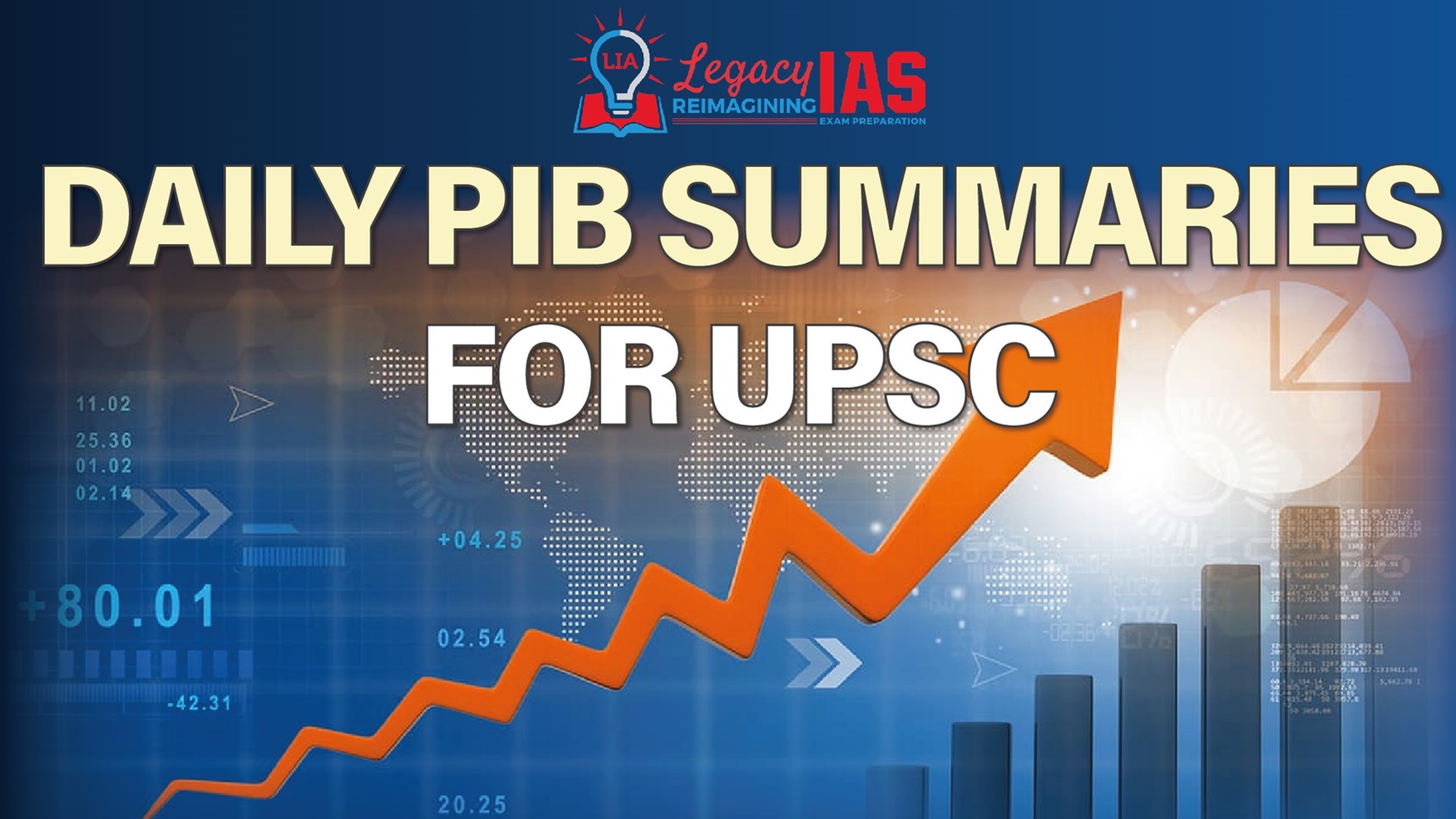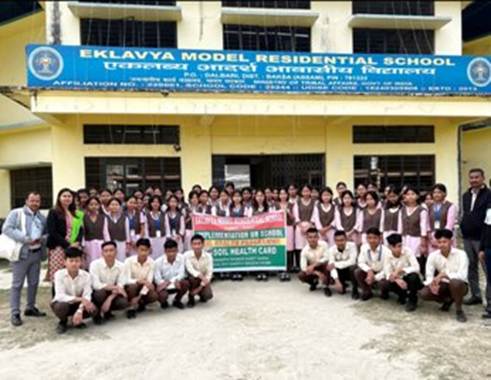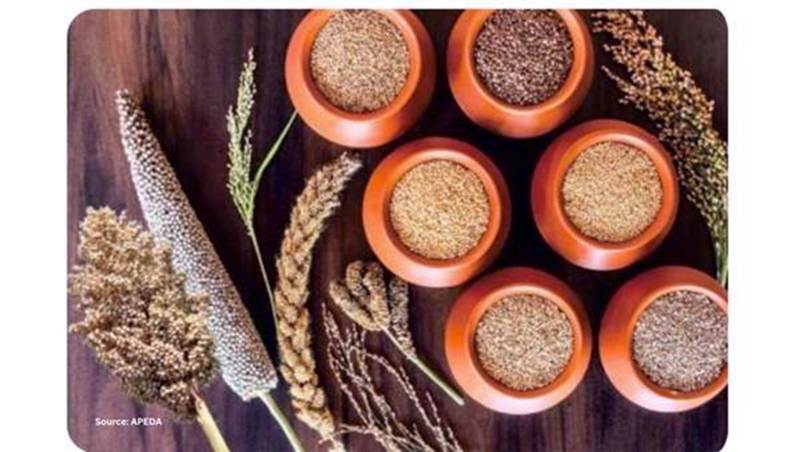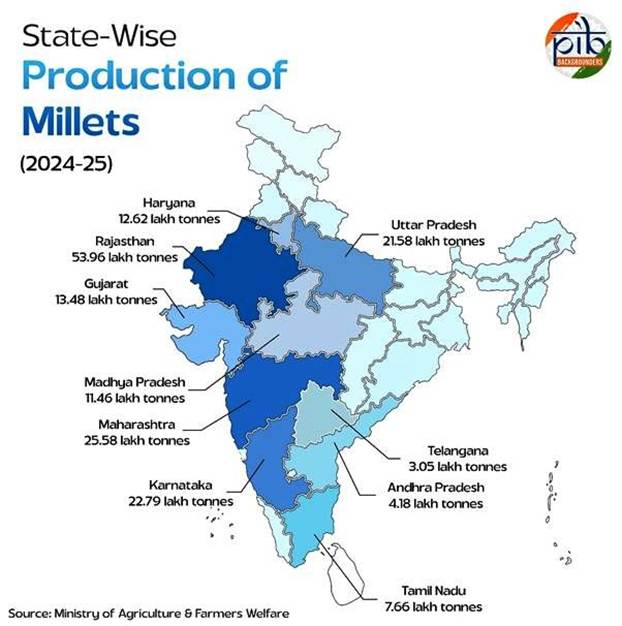Published on Aug 8, 2025
Daily PIB Summaries
PIB Summaries 08 August 2025

Content
- Tribal Day 2025: Building an Inclusive India Through Tribal Empowerment
- Shree Anna for Shreshta Bharat
Tribal Day 2025: Building an Inclusive India Through Tribal Empowerment
Context & Significance
- Occasion: World Tribal Day (International Day of the World’s Indigenous Peoples) – Aug 9, declared by UN in 1994 to raise awareness about indigenous peoples’ rights and contributions.
- India’s Indigenous Population:
- 10.42 crore Scheduled Tribe (ST) population (~8.6% of India’s population; Census 2011).
- Among 47.6 crore indigenous people across 90 countries.
- Government Philosophy: “Sabka Saath, Sabka Vikas, Sabka Vishwas, Sabka Prayaas” – focus on inclusive development and ensuring no tribal community is left behind.
Relevance : GS 1(Society ) , GS 2(Social Issues)
Budgetary & Institutional Framework
- Ministry of Tribal Affairs budget:
- 2014–15: ₹4,497.96 crore
- 2024–25: ₹13,000 crore (~3× increase).
- Development Action Plan for Scheduled Tribes (DAPST):
- Mandates 4.3%–17.45% of budgets in 42 central ministries/departments for tribal development.
- Funding growth: ₹21,525.36 crore (2013–14) → ₹1,24,908 crore (2024–25) (~5× increase).
- Covers 200+ schemes across education, health, agriculture, skill development, livelihoods, sanitation.
- DAPST expenditure (last 5 years):
- 2020–21: ₹48,084.10 crore
- 2021–22: ₹82,530.58 crore
- 2022–23: ₹90,972.76 crore
- 2023–24: ₹1,03,452.77 crore
- 2024–25 (Provisional): ₹1,04,436.24 crore

Flagship Village & PVTG Programs
PM Janjatiya Unnat Gram Abhiyan (PM JUGA / Dharti Aaba Janjatiya Gram Utkarsh Abhiyan)
- Launched: 2 Oct 2024, Hazaribagh, Jharkhand.
- Budget: ₹79,156 crore (till 2029).
- Coverage: ~63,843 tribal-majority villages & 112 Aspirational Districts.
- Progress (July 2025):
- 4 lakh+ pucca houses completed.
- 26,513 villages with piped water supply.
- 2,212 villages with mobile connectivity.
- 282 Anganwadi centres operational.
- 692 hostels sanctioned.
PM Janjati Adivasi Nyaya Maha Abhiyan (PM JANMAN)
- Target Group: 75 Particularly Vulnerable Tribal Groups (PVTGs) (~47.5 lakh people, 19 states/UTs).
- Budget: ₹24,104 crore.
- Defining traits of PVTGs:
- Pre-agricultural tech
- Low literacy
- Economic backwardness
- Declining/stagnant population
- Key progress (till June 2025):
- Pucca houses: 90,892 completed (target: 4.90 lakh).
- Piped water: 6,737 villages covered (target: 19,375).
- Mobile towers: 901 habitations covered (target: 4,543).
- Electrification: 92,311 households (target: 1.43 lakh).
Governance & Capacity Building
Aadi Karmayogi – Responsive Governance Programme
- Goal: Train 20 lakh grassroots tribal functionaries for better service delivery.
- Approach: Cascading training via Regional & State Process Labs.
- Integration: Works with PM JUGA & PM JANMAN to improve convergence, transparency, and participation.
Livelihood & Entrepreneurship
PM Janjatiya Vikas Mission (PM JVM)
- Started: 2021; Implemented via TRIFED.
- Focus: Tribal entrepreneurship, forest-based livelihoods.
- Events: 79 artisan melas, 50 exhibitions (2022–25).
Van Dhan Vikas Kendras (VDVKs)
- Structure: Each cluster = 15 SHGs (300 beneficiaries); funding: ₹15 lakh/cluster.
- Coverage:
- 4,661 VDVKs sanctioned; 12.8 lakh beneficiaries.
- Sales: ₹129.86 crore total.
Tribal Startups
- Initiative: Dharti Aaba TribePreneurs (April 2025).
- Support: ₹50 crore Venture Capital Fund for ST entrepreneurs; tie-ups with IIMs, IITs, IFCI, META.
- Recognition: Startups from Sikkim & Nagaland awarded for D2C travel services & sustainable agri-tech.
Education & Scholarships
Eklavya Model Residential Schools (EMRS)
- Current: 479 schools, 1.38 lakh students.
- Planned: 728 schools for 3.5 lakh students.
- Funding growth: ₹922.39 crore (2020–21) → ₹4,053.87 crore (2024–25).
- Staffing: 9,075 filled posts out of 38,480 sanctioned.
- Digital & Skill Initiatives:
- Smart classrooms, DTH channel, computer labs, Amazon Future Engineer, skill labs.
- IIT-JEE/NEET coaching partnerships (Avanti Fellows, Tata Motors).
Scholarships (2019–20 to 2024–25)
- Post Matric: 1.01 crore beneficiaries; ₹13,380.86 crore.
- Pre Matric: 54.41 lakh; ₹1,851.64 crore.
- National Fellowship: 0.16 lakh; ₹671.41 crore.
- Top Class Education: 0.22 lakh; ₹283.57 crore.
- National Overseas Scholarship: 269 students; ₹28.74 crore.
Health Interventions
- National Sickle Cell Anemia Elimination Mission (2023–2047): Target screening 7 crore people in tribal areas.
- Bhagwan Birsa Munda Chair of Tribal Health at AIIMS Delhi; 15 Centres of Competence in 14 states.
Rights & Legal Safeguards
- Forest Rights Act, 2006: 25.11 lakh land titles distributed to tribals & forest dwellers (till May 2025).
- NCSTGRAMS: Online grievance redressal; 1,747 cases registered in FY 2025–26 (till Aug 7).
Cultural Preservation
- Tribal Research Institutes (29): Document heritage, languages, folk arts. Funding (2020–25): ₹265.94 crore.
- Tribal Freedom Fighter Museums (11 sanctioned; 3 completed): Ranchi, Jabalpur, Chhindwara.
- Festivals:
- Janjatiya Gaurav Divas (15 Nov).
- Aadi Mahotsav – national platform; 2025 edition saw 600 artisans, 500 performers, MoUs with corporates & NIFT.
Strategic Implications for Inclusive Development
- Holistic approach: Combining infrastructure, health, education, livelihoods, rights, and culture.
- Budgetary commitment: Significant long-term scaling of central allocations.
- Decentralized delivery: PM JUGA & PM JANMAN’s village-level interventions target last-mile connectivity.
- Integration with Aspirational Districts Programme ensures high-impact targeting in lagging regions.
- Challenges ahead:
- Geographic remoteness & dispersed populations.
- High disease burden (sickle cell).
- Need for sustainable livelihoods beyond state support.
- Preservation of culture amid rapid integration.
Shree Anna for Shreshta Bharat
Basics of Millets
- Definition & Types
- Small-grained cereals, drought-resistant, adaptable to various soils and climates.
- Major millets: Sorghum (Jowar), Pearl millet (Bajra), Finger millet (Ragi).
- Small millets: Little millet (Kutki), Kodo millet (Kodo), Barnyard millet (Sawa), Foxtail millet (Kangni), Proso millet (Cheena).
- Nutritional Profile
- High in protein, fibre, vitamins (B-complex), minerals (iron, calcium, magnesium).
- Gluten-free, low glycaemic index → suitable for diabetics and celiac patients.
- Superior nutritional quality vs wheat & rice → “Nutritious Cereals” / “Shree Anna”.
- Climate Resilience
- Requires less water, grows in degraded soils, withstands temperature extremes.
- Short crop cycle → better fit for climate-smart agriculture.
Relevance : GS 2(Governance ) , GS 3(Agriculture)

India’s Global Standing & Production Trends
- Largest Producer Globally: 38.4% of global millet production (FAO, 2023).
- Production (2024–25): 180.15 lakh tonnes — ↑4.43 lakh tonnes from previous year.
- Top Producing States (2024–25):
- Rajasthan
- Maharashtra
- Karnataka
- Crop-wise share: Bajra (largest) > Jowar > Ragi > Small millets.
Policy & Budgetary Support
Cultivation Support
- National Food Security Mission – Nutri Cereals
- Covers 28 States + UTs of J&K and Ladakh.
- Includes major & small millets.
- Assistance: cluster demonstrations, HYV seeds, modern farm machinery, irrigation tools, soil health inputs, farmer training.
- Umbrella scheme under Krishionnati Yojana: ₹8,000 crore (2025–26).
- Pradhan Mantri Rashtriya Krishi Vikas Yojana (PM RKVY)
- Flexible for states’ priorities including millets.
- Budget: ₹8,500 crore (2025–26).
Processing & Value Chain Development
- PM-FME Scheme
- Focus: Micro food processing units (incl. millet-based products).
- Budget: ₹2,000 crore (2025–26).
- Production Linked Incentive Scheme for Millet-Based Products (PLISMBP)
- Encourages RTE/RTC millet products with ≥15% millet content (domestically sourced).
- ₹800 crore outlay (part of PLISFPI) — ₹793.27 crore approved for 29 companies.
- Linked to ≥10% annual sales growth.

Export Promotion
- APEDA: ₹80 crore (2025–26) for millet exports.
- Exports (2024–25): 89,164.96 tonnes, worth $37 million.
- Initiatives: Export Promotion Forum, dedicated millet portal, start-up & research partnerships, branding and market linkages.
Research & Development
- ICAR – Indian Institute of Millets Research (IIMR), Hyderabad
- Global Centre of Excellence (2023).
- Focus: HYV seeds, farmer training, value addition, FPO promotion.
- State collaborations (Odisha, Karnataka, Jharkhand, Tamil Nadu, Telangana, Chhattisgarh).
Public Procurement & Distribution
- Integrated into PM-GKAY and NFSA.
- States can substitute wheat/rice with millets under PDS upon request.
- PM-GKAY allocation: ₹2,03,000 crore (2025–26).
State-Level Best Practices
- Andhra Pradesh (APDMP): IFAD-supported drought mitigation via FPOs, minor millet varieties, millet-based recipes.
- Chhattisgarh Millet Mission (2021): Tribal inclusion, decentralised processing, ICAR-IIMR MoU for Kodo, Kutki, Ragi.
- Haryana – Bhavantar Bharpayee Yojana: Price compensation (up to ₹600/qtl for Bajra), crop diversification.
- Odisha Millet Mission (2017): Tribal focus, ragi revival, millet in Anganwadi food, Millet Shakti Cafés, incubation centres, ODOP designation.
- Nagaland – NFSM Nutri-Cereals: Foxtail millet promotion, seed distribution, pest/nutrient management.
Millets Mainstreaming Framework
- Value Chain Stages:
- Production – HYV seeds, irrigation, training.
- Storage & Transport – post-harvest loss reduction, better storage.
- Processing – cleaning, grading, tech adoption (esp. for small millets).
- Packaging & Branding – nutrition labelling, organic certification, brand building.
- Distribution – market linkages, exports, FPO collaboration.
- Consumption – awareness drives, millet-based snacks in govt offices/events.
- Foundations: Institutional support, finance access, partnerships, policy facilitation, gender inclusion.
- Visibility: Millets Experience Centre at Dilli Haat.
Broader Significance
- Economic: Diversifies farmer income, reduces crop risk, boosts exports.
- Nutritional Security: Tackles malnutrition and lifestyle diseases.
- Climate Adaptation: Low water footprint, heat/drought tolerance.
- Social Impact: Supports tribal farmers, women’s SHGs, rural entrepreneurship.
Key Challenges Ahead
- Limited processing infrastructure in some regions.
- Consumer awareness and taste preferences still skewed towards rice/wheat.
- Need for stronger private sector investment in millet-based product innovation.
- Post-International Year of Millets momentum must be sustained through continuous policy push.
